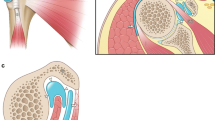Abstract
Objective
The purpose of this study was to describe the sonographic findings of pathologically confirmed subcutaneous lobular capillary hemangioma of the finger in six patients.
Materials and methods
The clinical records were reviewed for data, including the patients’ age and gender, the clinical presentation, a history of trauma, and the tumor site. The sonographic findings were retrospectively analyzed for the specific location within the superficial tissue, the tumor’s size, shape, and margin, the internal echogenicity, the internal echo texture, the presence of calcification, the presence of a hypoechoic rim, and the internal vascularity.
Results
The study group consisted of three men and three women, and the six patients’ mean age was 39 years (age range: 13-67 years). All the patients were admitted with a painful nodule or a painless protruding nodule in the finger with easy bleeding on contact. In all cases, there was no history of trauma. The mean size of the tumors was 0.85 cm. All the tumors were ill-defined, oval, subcutaneous nodules without calcifications or any hypoechoic rim. Color Doppler sonography showed marked internal vascularity in both the central and peripheral tumor regions in three cases and scanty vascularity in the peripheral region in three cases.
Conclusions
Subcutaneous lobular capillary hemangioma should be considered when an ill-defined, oval, vascular subcutaneous nodule without calcifications or a hypoechoic rim is seen in the soft tissue of the finger, especially if this tumor is a painful small nodule or a painless protruding small nodule with easy bleeding on contact.




Similar content being viewed by others
References
Cooper PH, Mills SE. Subcutaneous granuloma pyogenicum: lobular capillary hemangioma. Arch Dermatol. 1982;118:30–3.
Harris MN, Desai R, Chuang TY, Hood AF, Mirowski GW. Lobular capillary hemangiomas: an epidemiologic report, with emphasis on cutaneous lesions. J Am Acad Dermatol. 2000;42:1012–6.
Fortna RR, Jacqueline M. A case of lobular capillary hemangioma (pyogenic granuloma), localized to the subcutaneous tissue, and a review of the literature. Am J Dermatopathol. 2007;29:408–11.
Kuroda K, Mizoguchi M. Subcutaneous granuloma pyogenicum in patients with antiphospholipid antibodies. Dermatology. 2004;208:331–4.
Ghersin E, Nitecki S, Brook OR, et al. Intraluminal pyogenic granuloma of the basilic vein: color duplex sonographic manifestations. J Ultrasound Med. 2004;23:443–5.
Maddison A, Tew K, Orell S. Intravenous lobular capillary haemangioma: ultrasound and histology findings. Australas Radiol. 2006;50:186–8.
Ghekiere O, Galant C, Vande Berg B. Intravenous pyogenic granuloma or intravenous lobular capillary hemangioma. Skeletal Radiol. 2005;34:343–6.
Song MG, Kim HJ, Lee ES. Intravenous pyogenic granuloma. Int J Dermatol. 2001;40:57–9.
Taira JW, Hill TL, Everett MA. Lobular capillary hemangioma (pyogenic granuloma) with satellitosis. J Am Acad Dermatol. 1992;27:297–300.
Kamishima T, Hasegawa A, Kubota KC, et al. Intravenous pyogenic granuloma of the finger. Jpn J Radiol. 2009;27:328–32.
Teefey SA, Dahiya N, Middleton WD, Gelberman RH, Boyer MI. Ganglia of the hand and wrist: a sonographic analysis. AJR Am J Roentgenol. 2008;191:716–20.
Horcajadas AB, Lafuente JL, de la Cruz Burgos R, et al. Ultrasound and MR findings in tumor and tumor-like lesions of the fingers. Eur Radiol. 2003;13:672–85.
Bianchi S, Della Santa D, Glauser T, Beaulieu JY, Van Aaken J. Sonography of masses of the wrist and hand. AJR Am J Roentgenol. 2008;191:1767–75.
Hwang JY, Lee SW, Lee SM. The common ultrasonographic features of pilomatricoma. J Ultrasound Med. 2005;24:1397–402.
Fornage BD. Glomus tumors in the fingers: diagnosis with US. Radiology. 1988;167:183–5.
Gomez-Dermit V, Gallardo E, Landeras R, Echevarría F, García Barredo R. Subcutaneous angioleiomyomas: gray-scale and color Doppler sonographic appearances. J Clin Ultrasound. 2006;34:50–4.
Conflict of interest
There is no financial sponsor of this research. The authors declare that they have no conflict of interest.
Author information
Authors and Affiliations
Corresponding author
Rights and permissions
About this article
Cite this article
Lee, G.K., Suh, K.J., Lee, J.H. et al. Lobular capillary hemangioma in the soft tissue of the finger: sonographic findings. Skeletal Radiol 39, 1097–1102 (2010). https://doi.org/10.1007/s00256-010-0934-0
Received:
Revised:
Accepted:
Published:
Issue Date:
DOI: https://doi.org/10.1007/s00256-010-0934-0




